Chapter 4: Pricing
Chapter learning objectives
Upon completion of this chapter you will be able to:
- explain the factors that influence the pricing of a product or service, e.g. costs, demand and competition
- define and explain the price elasticity of demand
- from supplied data, derive and manipulate a straight-line demand equation
- from supplied data, derive an equation for the total cost function excluding or including volume-based discounts
- using data supplied or equations derived, advise on whether or not to increase production and sales levels considering incremental costs, incremental revenues and other factors
- explain, using a simple example, all forms of cost-plus pricing strategy
- calculate, for given data, a price using a cost-plus strategy
- explain different pricing strategies
- identify suitable pricing strategies for given situations from skimming, penetration, complementary product, product-line, volume discounting
- explain, using a simple example, a price-discrimination pricing strategy
- explain, using a simple example, a relevant-cost pricing strategy
- calculate, for given data, a price using a relevant cost strategy.
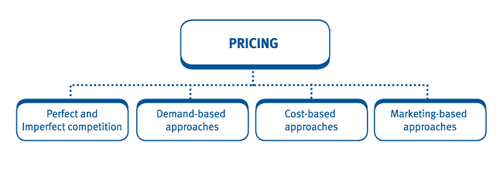
1 Introduction
Pricing is important because:
- It makes a pivotal contribution to profit maximisation – the overriding aim of most businesses.
- Businesses make profits by selling goods and services at a price higher than their cost.
- The amount that they are able to sell will often be determined by the price charged for the goods and services.
2 Different types of market structures
The price that a business can charge for its products or services will be determined by the market in which it operates.
In a perfectly competitive market, every buyer or seller is a'price taker', and no participant influences the price of the productit buys or sells. Other characteristics of a perfectly competitivemarket include:
- Zero Entry/Exit Barriers – It is relatively easy to enter or exit as a business in a perfectly competitive market.
- Perfect Information - Prices and quality of products are assumed to be known to all consumers and producers.
- Companies aim to maximise profits - Firms aim to sell where marginal costs meet marginal revenue, where they generate the most profit.
- Homogeneous Products – The characteristics of any given market good or service do not vary across suppliers.
Imperfect competition refers to the market structure that does not meet the conditions of perfect competition. Its forms include :
- Monopoly, in which there is only one seller of a good. The seller dominates many buyers and can use its market power to set a profit-maximising price. Microsoft is usually considered a monopoly.
- Oligopoly, in which a few companies dominate the market and are inter-dependent : firms must take into account likely reactions of their rivals to any change in price, output or forms of non-price competition. For example, in the UK, four companies (Tesco, Asda, Sainsbury's and Morrisons) share 74.4% of the grocery market.
- Monopolistic competition, in which products are similar, but not identical. There are many producers ('price setters') and many consumers in a given market, but no business has total control over the market price.

 Illustration 1 - Monopolistic competition
Illustration 1 - Monopolistic competition
For example, there are many different brands of soap on the markettoday. Each brand of soap is similar because it is designed to get theuser clean; however, each soap product tries to differentiate itselffrom the competition to attract consumers. One soap might claim that itleaves you with soft skin, while another that it has a clean, freshscent. Each participant in this market structure has some control overpricing, which means it can alter the selling price as long as consumersare still willing to buy its product at the new price. If one productcosts twice as much as similar products on the market, chances are mostconsumers will avoid buying the more expensive product and buy thecompetitors' products instead. Monopolistic products are typically foundin retailing businesses. Some examples of monopolistic products and/orservices are shampoo products, extermination services, oil changes,toothpaste, and fast-food restaurants.

3 Three broad approaches to pricing
Pricing decisions may be separated into three broad approaches :
(1) Demand-based approaches
(2) Cost-based approaches
(3) Marketing-based approaches
4 Demand-based approaches (The Economists' Viewpoint)
Most firms recognise that there exists a relationship between theselling price of their product or service and the demand. Thisrelationship can often be described by an inverse, linear relationship:
By investigating and analysing this relationship it is possible (intheory) to establish an optimum price, i.e. a price that will maximiseprofits. There are two methods of solution to problems investigating therelationship between price and demand: the tabular approach and thealgebraic approach.

 Illustration 2 - Tabular Approach
Illustration 2 - Tabular Approach
XYZ Ltd is introducing a new product. The company intends to hiremachinery to manufacture the product at a cost of $200,000 per annum.However, this will only enable 60,000 units per annum to be produced,although additional machines can be hired at $80,000 per annum.
Each machine hired enables capacity to be increased by 20,000 unitsper annum, but it is not possible to increase production beyond 90,000units because of shortage of space.
The minimum rental period is for one year and the variable cost is estimated to be $6 per unit produced.
There are no other fixed costs that can be specifically traced tothe product. Marketing management has estimated the maximum sellingprices for a range of output from 50,000 units to 90,000 units. Theestimates are as follows:

(*) At $15 demand will be in excess of 90,000 units but production capacity will limit the sales.
What is the optimum price and quantity of units to output and sell (assume all units of production can be sold)?


 Tabular Approach - Solution
Tabular Approach - Solution
Answer guide

Conclusion: To maximise profit, price should be $18, output 80,000 and one extra machine should be hired.

5 The algebraic approach
Economic theory states that the monopolist maximises profit when Marginal Cost = Marginal Revenue.

 Illustration 3 - The MR= MC
Illustration 3 - The MR= MC
Marginal Revenue is the additional revenue from selling one extra unit, for example :

Marginal Cost is the cost from making one more unit. It is usually just the variable cost, e.g. MC = $30.
The optimum price is $50. At output less than Q = 3, the extra costof making a unit is less than the extra revenue from selling it. Atoutput greater than Q = 3, the extra costs of making a unit exceed therevenue from selling it.

6 Procedure for establishing the optimum price of a product
This is a general set of rules that can be applied to most questions involving algebra and pricing.
(1) Establish the linear relationship between price (P) and quantity demanded (Q). The equation will take the form:
P = a + bQ
where 'a' is the intercept and 'b' is the gradient of the line.As the price of a product increases, the quantity demanded willdecrease. The equation of a straight line P= a + bQ can be used to showthe demand for a product at a given price:
Note: ‘b' is always negative because of the inverse relationship between price and quantity.
(2) Double the gradient to find the marginal revenue: MR = a – 2bQ.
(3) Establish the marginal cost MC. This will simply be the variable cost per unit.
(4) To maximise profit, equate MC and MR and solve to find Q.
(5) Substitute this value of Q into the price equation to find the optimum price.
(6) It may be necessary to calculate the maximum profit.

 The price elasticity of demand
The price elasticity of demand
When a business proposes to change the price of a product orservice the key question is: ‘to what degree will demand be affected?'
Calculation
The price elasticity of demand measures the change in demand as a result of a change in its price.
It can be calculated as follows:
Example: assume that the sales of a retailer fall from 20per day to 12 per day when the price of a chocolate bar goes up from 40cto 60c. The price elasticity can be calculated as follows:
%change in price = (increase in price of 20/original price of 40) × 100 = +50%
%change in demand =(decrease in demand of – 8/original demand of 20) × 100 = – 40%
PED = – 40/+50 = – 0.8
The negative sign should be ignored in the PED calculation. Therefore the PED = 0.8.
Interpretation of PED
Elastic demand
If the % change in demand > the % change in price, then price elasticity > 1.
Demand is ‘elastic', i.e. very responsive to changes in price.
- Total revenue increases when price is reduced.
- Total revenue decreases when price is increased.
Therefore, price increases are not recommended but price cuts are recommended.
Inelastic demand
If the % change in demand < the="" %="" change="" in="" price,="" then="" price="" elasticity=""><>
Demand is ‘inelastic', i.e. not very responsive to changes in price.
- Total revenue decreases when price is reduced.
- Total revenue increases when price is increased.
Therefore, price increases are recommended but price cuts are not recommended.


 Additional example on straight-line demand equation
Additional example on straight-line demand equation
(a) Find the linear relationship between price (P) and the quantity demanded (Q) in relation to the following sales and demand data:
- Selling price of $300 = sales of 500 units per month.
- Selling price of $330 = sales of 400 units per month.
(b) Using the price equation in (a) and assuming the variable cost per unit is $90, calculate the optimum price and output.
(c) Calculate the maximum contribution.
Solution
a.
- P = a – bQ
- – b (gradient) = (330 – 300) ÷ (400 – 500) = – 0.3
- remembering that price (P) = 300 when 500 units are sold and substituting 0.3 for b
- 300 = a – (0.3 × 500)
- 300 = a – 150
- a = 300 + 150 = 450
- So the linear relationship (or demand function equation) is: P = 450 – 0.3Q.
(b) MR = 450 - 0.6Q
MC = VC so equating MR = MC: 90 = 450 - 0.6Q
So Q = 600
And substituting Q into Price function, P = $270
(c) Contribution per unit = $270 - $90 = $180
Total contribution = $180 x 600 units = $108,000


 Test your understanding 1
Test your understanding 1
Find the linear relationship between price (P) and the quantitydemanded (Q), i.e. find the straight-line demand equation, in relationto the following sales and demand data:
- Selling price of $200 = sales of 1,000 units per month.
- Selling price of $220 = sales of 950 units per month.
Required:
(a) Use this equation to predict the quantity demanded per month if the selling price is $300.
(b) Using the price equation in (a) and assuming the variable cost per unit is $100, calculate the optimum price and output.
(c) Calculate the maximum contribution.


 Test your understanding 2
Test your understanding 2
The total fixed costs per annum for a company that makes oneproduct are $100,000, and a variable cost of $64 is incurred for eachadditional unit produced and sold over a very large range of outputs.
The current selling price for the product is $160. At this price, 2,000 units are demanded per annum.
It is estimated that for each successive increase in price of $5annual demand will be reduced by 50 units. Alternatively, for each $5reduction in price, demand will increase by $50 units.
Required:
(a) Calculate the optimum output and price,assuming that if prices are set within each $5 range there will be aproportionate change in demand.
(b) Calculate the maximum profit.

7 Equation for the total cost function
Cost equations are derived from historical cost data. Once a costequation has been established (using methods such as the high/low methodwhich will be revised later in the course) it can be used to estimatefuture costs. In the exam, cost functions will be linear:
y = a + bx
- ‘a' is the fixed cost per period (the intercept)
- ‘b' is the variable cost per unit (the gradient)
- ‘x' is the activity level (the independent variable)
- ‘y' is the total cost = fixed cost + variable cost (the dependent variable).
Suppose a cost has a cost equation of y = $5,000 + 10x, this can be shown graphically as follows:

 Test your understanding 3
Test your understanding 3
- Fixed costs $100,000.
- Variable costs per unit $5 for volumes up to 1,000 units.
- Volumes above 1,000 units receive 5% discount on all units.
Required:
Derive the two equations for the total cost function.


 Additional example on the total cost function
Additional example on the total cost function
Consider the linear function y = 1,488 + 20x and answer the following questions.
(a) The line would cross the y axis at the point
(b) The gradient of the line is
(c) The independent variable is
(d) The dependent variable is
Solution


Cost-based pricing: the accountant's approach
'Cost plus' pricing is a much favoured traditional approach to establishing the selling price by:
- calculating the unit cost
- adding a mark-up or margin to provide profit.
Cost-plus pricing is more suited to businesses that:
- sell the product in large volumes
- operate in markets dominated by price.
The unit cost may reflect:
- full cost
- production costs only
- variable costs only.
The profit is equally subjective and often reflects:
- the risk involved in the product
- competitors' mark-ups
- desired profit and/or ROCE (return on capital employed)
- type of cost used
- type of product.
It is important to understand the difference between:
- Profit mark-up: the profit is quoted as a percentage of the cost.
- Profit margin: the profit is quoted as a percentage of the selling price.

 Test your understanding 4
Test your understanding 4
If the full cost of an item is $540, calculate the selling price using a 25% mark up and a 25% profit margin.

8 Cost equations including volume-based discounts
Suppliers often offer discounts to encourage the purchase of increased volumes.
Where volume-based discounts are offered a total cost equation can be derived for each volume range.

 Additional example on volume-based discounts
Additional example on volume-based discounts
You are given the following cost data:

Required:
Derive equations for the total cost function.
Solution
y = 250,000 + 6x for x ≤ 5000.
y = 250,000 + 5.4x for x > 5000.

9 Increasing sales and production levels
When an opportunity to increase sales and production levels arises in a business the key question to answer is:
- will the increased contribution (sales less variable costs) generated by the increased sales exceed any additional fixed costs that will be incurred as a result of the increased sales level?
If the answer is ‘yes' the opportunity should normally be pursued.

 Test your understanding 5
Test your understanding 5
An opportunity arises to increase sales by 10,000 units:
- Selling price of additional units = $10
- Variable cost of additional units = $6
- Fixed costs will increase by = $50,000
Required:
Should the opportunity be accepted?


 Additional example on increasing volumes
Additional example on increasing volumes
A company produces and sells one product and its forecast for the next financial year is as follows:
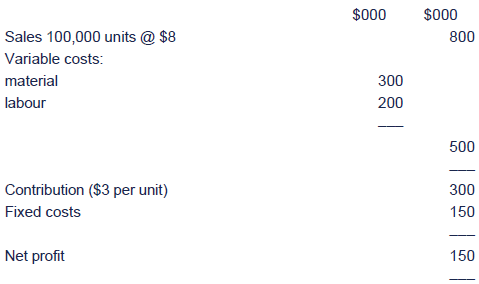
In an attempt to increase net profit, two proposals have been put forward:
(a) To launch an advertising campaign costing$14,000. This will increase the sales to 150,000 units, although theprice will have to be reduced to $7.
(b) To produce some components at presentpurchased from suppliers. This will reduce material costs by 20% butwill increase fixed costs by $72,000.
Required:
Decide whether these proposals should be pursued.
Solution
Proposal (a) will increase the sales revenue but the increase in costs will be greater:
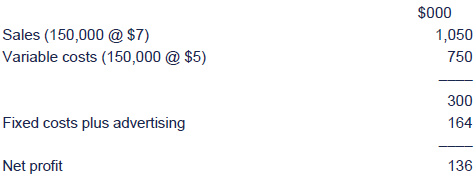
This is lower than the current forecast.
Proposal (b)
- reduces variable costs by $60,000 ($300,000 x 20%)
- but increases fixed costs by $72,000 and is therefore not to be recommended unless the total volume increases as a result of the policy (e.g. if the supply of the components were previously a limiting factor).
Conclusion
Neither proposal should be accepted.


 Additional example of cost-plus pricing
Additional example of cost-plus pricing
When using a cost-plus pricing strategy a business should work through a step by step approach. For example:
Step 1: Establish the cost per unit. For example, if full cost is used this may be:

Step 2: Add the target profit to arrive at the selling price. For example:
- 20% mark-up = selling price of $120 per unit
- 20% sales margin = selling price of $125 per unit
Step 3: Consider how realistic the target profit is. This will depend upon:
- accurate knowledge of costs
- the selling price arrived at being one which customers are prepared to pay
- selling the planned volume of goods.


 Advantages and disadvantages of cost-plus pricing
Advantages and disadvantages of cost-plus pricing
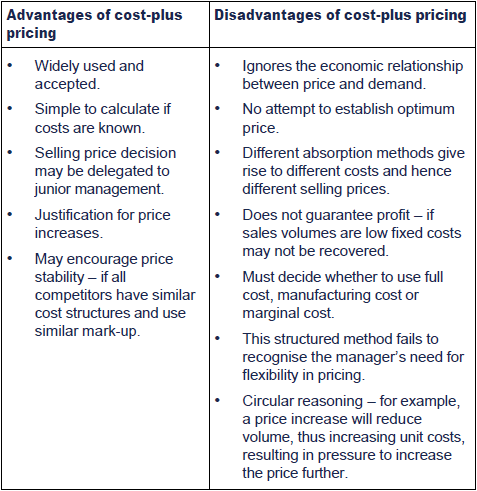

Customer based pricing – the marketer's approach
Customer-based pricing reflects customers' perceptions of thebenefits they will enjoy from purchasing the product, e.g. convenience,status. The product is priced to reflect these benefits.
This approach has regard to costs but reflects a belief that thegreater understanding you have of your customer the better placed youare to price the product.

 Illustration 4 – Customer-based pricing
Illustration 4 – Customer-based pricing
On a remote beach in a hot country, the offer of food and drink totourists on the beach will be perceived by them as being of significantbenefit and they are likely to be prepared to pay a significant amountin excess of cost.


 Test your understanding 6
Test your understanding 6
Of the three approaches to pricing discussed above:
- cost-based
- customer-based
- competition-based,
which is the least likely to maximise profits and why?

Competition-based pricing
Competition-based pricing means setting a price based upon the prices of competing products.
Competing products can be classified as:
- The same type of product which is not easily distinguished from one's own products. For example, petrol sold at two competing petrol stations.
- price changes by competitors will have a material impact.
- Substitute products which are different products but fulfil the same need, e.g. you may buy ice cream instead of soft drinks on a hot day.
- impact of price changes will depend on relative price/performance of substitute.
10 Different pricing strategies
There are a number of different pricing strategies available to a business:
- Cost-plus pricing
- Market-skimming
- Penetration pricing
- Complementary product pricing
- Product-line pricing
- Volume discounting
- Price discrimination
- Relevant cost pricing
Each strategy will be reviewed in turn.
11 Market-skimming pricing strategy
What is market skimming?
Market skimming involves charging high prices when a product isfirst launched in order to maximise short-term profitability. Initiallyhigh prices may be charged to take advantage of the novelty appeal of anew product when demand is initially inelastic.
Once the market becomes saturated the price can be reduced to attract that part of the market that has not been exploited.
Conditions suitable for a market-skimming strategy
- Where the product is new and different and has little direct competition. This is the most common reason for using a market-skimming strategy.
- Where products have a short life cycle, and there is a need to recover their development costs quickly and make a profit.
- Where the strength of demand and the sensitivity of demand to price are unknown. From a psychological point of view it is far better to begin with a high price, which can then be lowered if the demand for the product appears to be more price sensitive than at first thought.
- A firm with liquidity problems may use market-skimming in order to generate high cash flows early on.
With high prices being charged potential competitors will betempted to enter the market. For skimming to be sustained one or moresignificant barriers to entry must be present to deter these potentialcompetitors. For example, patent protection, strong brand loyalty.

 Test your understanding 7
Test your understanding 7
What products may be priced using a market-skimming strategy?

12 Penetration pricing strategy
What is penetration pricing?
- Penetration pricing is the charging of low prices when a new product is initially launched in order to gain rapid acceptance of the product.
- Once market share is achieved, prices are increased.
- It is an alternative to market skimming when launching a new product.
Circumstances which favour a penetration policy
- If the firm wishes to increase market share.
- A firm wishes to discourage new entrants from entering the market.
- If there are significant economies of scale to be achieved from high-volume output, and so a quick penetration into the market is desirable.
- If demand is highly elastic and so would respond well to low prices.

 Illustration 5 – Penetration pricing strategy
Illustration 5 – Penetration pricing strategy
The 2006 launch of Microsoft's anti-virus product, Windows LiveOneCare, was described by commentators as an example of penetrationpricing. Microsoft's competitors in this market (e.g. Symantec andMcAfee) reportedly lost material market share within a few months of itslaunch.

13 Complementary-product pricing
What is a complementary product?
A complementary product is one that is normally used with anotherproduct. An example is razors and razor blades – if sales of razorsincrease more razor blades will also be bought.
Other examples of complementary products are:
- game consoles and associated games
- printers and printer cartridges.
Complementary goods provide suppliers with additional power over the consumer.

 Illustration 6 – What is complementary-product pricing?
Illustration 6 – What is complementary-product pricing?
A complementary-product pricing strategy can take two forms:
- The major product (e.g. a printer or a camera) is priced at a relatively low figure – to encourage the purchase and lock the consumer into subsequent purchases of relatively high price consumables (e.g. printer cartridges or memory cards). This is the most common form.
- The major product (e.g. membership of a fashionable sports or golf club) is priced at a relatively high figure – to create a barrier to entry and exit and the consumer is locked into subsequent purchases of relatively low-price facilities (e.g. court fees or green fees).

14 Product-line pricing strategy
What is a product line?
A product line is a range of products that are related to oneanother. All products within the product line are related but may varyin terms of style, colour, quality, price etc.
What is product-line pricing?
Product-line pricing works by:
- capitalising on consumer interest in a number of products within a range.
- making the price entry point for the basic product relatively cheap.
- pricing other items in the range more highly – in order to ‘complete the set' the consumer has to pay substantially more for the additional matching items.

 Illustration 7 – Product-line pricing strategy
Illustration 7 – Product-line pricing strategy
A dinner service is being promoted. The entry point (servingplates) will be relatively cheap. Other, less essential matching itemsin the same range (e.g. gravy boats) will have a higher price.

15 Volume-discounting pricing strategy
What is volume-discounting pricing?
Volume discounting means offering customers a lower price per unit if they purchase a particular quantity of a product.
It takes two main forms:
- Quantity discounts – for customers that order large quantities.
- Cumulative quantity discounts – the discount increases as the cumulative total ordered increases. This may appeal to those who do not wish to place large individual orders but who purchase large quantities over time.
Benefits to the business of using a volume discounting strategy
- Increased customer loyalty – cumulative quantity discounts ‘lock in' the customer since further purchases can be made at a lower cost per unit.
- Attracting new customers – an exceptional level of discount can be offered to new customers on a one-off basis, enabling the supplier to ‘get his foot in the door'.
- Lower sales processing costs – an increased proportion of his sales take the form of bulk orders.
- Lower purchasing costs – high sales volumes enable the business to enjoy discounts from their suppliers, creating a virtuous circle.
- Discounts help to sell items that are bought primarily on price.
- Clearance of surplus stock or unpopular item through the use of discounts.
- Discounts can be geared to particular off-peak periods.
Conditions suitable for a volume-discounting pricing strategy
- Sales margin is substantial allowing profits to be made even after discounting.
- The product is bought on price and it is difficult to distinguish it from competing products.
- Products with a limited shelf life ( for example, fashion items) may be discounted to shift them.

 Recap of pricing strategies for a given situation
Recap of pricing strategies for a given situation
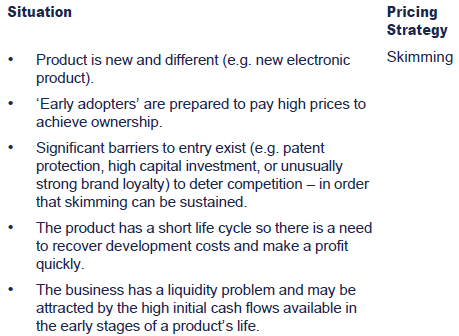
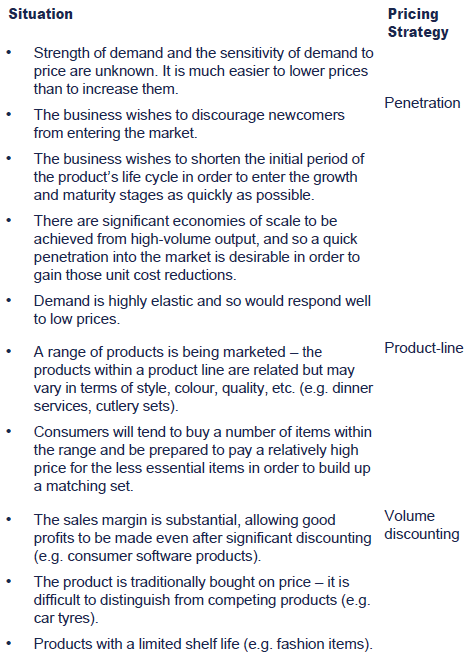

16 Price-discrimination pricing strategy
What is price-discrimination?
A price-discrimination strategy is where a company sells the same product at different prices in different markets.
Conditions required for a price-discrimination strategy
- The seller must have some degree of monopoly power, or the price will be driven down.
- Customers can be segregated into different markets
- Customers cannot buy at the lower price in one market and sell at the higher price in the other market.
- There must be different price elasticities of demand in each market so that prices can be raised in one and lowered in the other to increase revenue.
Dangers of price-discrimination as a strategy
- A black market may develop allowing those in a lower priced segment to resell to those in a higher priced segment.
- Competitors join the market and undercut the firm's prices.
- Customers in the higher priced brackets look for alternatives and demand becomes more elastic over time.

 Test your understanding 8
Test your understanding 8
Which products or services lend themselves to a price-discrimination strategy?


 Test your understanding 9 - Recap of pricing strategies
Test your understanding 9 - Recap of pricing strategies
(1) Which pricing strategies are aimed at the start of the product life cycle?
(2) Which pricing strategies seek to attract sales by offering a product at a relatively low price?
(3) Which pricing strategies lure the customerin with a relatively low-priced product in order to lock the customer into subsequent additional purchases of similar items that are relativelyhighly priced?
(4) Which pricing strategy is appropriate to items that are bought primarily on price.

17 Using relevant costs to arrive at a price
What is relevant cost pricing?
The principles of relevant costing were met in paper F2 and will be reviewed in more detail in a later chapter.
Relevant costs can be used to arrive at a minimum tender price for aone-off tender or contract. The minimum price should be equal to thetotal of all of the relevant cash flows.
Suitability of relevant cost pricing
The use of relevant costs is only suitable for a one-off decision since:
- fixed costs may become relevant in the long run
- there are problems estimating incremental cash flows
- there is a conflict between accounting measures such as profit and this approach.
Calculations involving relevant cost pricing will be reviewed in a later chapter.
18 Chapter summary
Test your understanding answers

 Test your understanding 1
Test your understanding 1
(a) Step 1: Find the gradient, b
The question provides us with two selling prices and therespective level of demand at these selling prices. Therefore, we canbegin by calculating the gradient of the straight line, b.
b (gradient) = change in price/ change in quantity = (220 – 200)/(950 – 1000) = – 0.4
Step 2: Calculate the intersect, a
Once the gradient is known the intersect can be found usingeither of the selling prices and demand levels given in the question.
For example, price (P) = 200 when 1000 units (Q) are sold and substituting – 0.4 for b
200 = a – (0.4 × 1,000)
200 = a – 400
a = 200 + 400 = 600
Step 3: Straight-line demand equation
So the equation is: P = 600 – 0.4Q.
Step 4: Forecast the demand at a given selling price
At a price of $300
300 = 600 – 0.4Q
0.4Q = 300
Q = 300/0.4
Quantity demanded (Q) = 750 units per month
(b) MR = 600 - 0.8Q
MC = VC so equating MR = MC: 100 = 600 - 0.8Q
So Q = 625
And substituting Q into Price function, P = $350
(c) Contribution per unit = $350 - $100 = $250
Total contribution = $250 x 625 units = $156,250


 Test your understanding 2
Test your understanding 2
(a) Let Q = quantity produced/sold
Gradient 'b'=

b = – 0.1
Price = a - 0.1Q; $160 = a – 0.1 (2,000) therefore a = $360
P = $360 - 0.1Q
MR = $360 - 0.2Q
MC = $64
(b) To maximise profit, MR = MC. Therefore, $360 - 0.2Q = $64



 Test your understanding 3
Test your understanding 3
- Y = 100,000 + 5x for x≤1000
- Y = 100,000 + 4.75x for x>1000.


 Test your understanding 4
Test your understanding 4
- A 25% mark-up would produce a selling price of $675 ($540 × 125/100).
- A 25% profit margin would produce a selling price of $720 [$540 × (100/75)].


 Test your understanding 5
Test your understanding 5
The effect of the increased sales would be to reduce net profits by $10,000.
- $100,000 increased sales ($10 × 10,000 units)
- $60,000 increased variable costs ($6 × 10,000 units) = $40,000 additional contribution
- less additional fixed costs of $50,000 = $10,000 reduction in net profit.
Based on this analysis, the opportunity should be rejected. However, other factors need to be considered such as:
- the impact on future sales beyond the current period
- the impact of rejection on customer goodwill
- whether the extra sales would help build the firm's brand.


 Test your understanding 6
Test your understanding 6
Customer-based and competition-based pricing are most likely tomaximise profits since they take into account the behaviour of customersand competitors, as well as the need to recover costs or obtain aparticular margin on sales. Cost-based pricing, in contrast, simplyreflects the objective of cost recovery or achieving a margin on salesand ignores the potential to exploit the level of customers' interest inthe product or the strength of the product in the marketplace relativeto competitors.


 Test your understanding 7
Test your understanding 7
Market skimming is often used in relation to electronic productswhen a new range (e.g. DVD players, plasma TV screens) are firstreleased onto the market at a high price.
The target is the 'early adopters' of such products; their pricesensitivity is relatively low because their interest in the product issubstantial or they have a stronger appreciation of the qualitiesoffered by the product.


 Test your understanding 8
Test your understanding 8
Examples of price discrimination include:
- lower admission prices for children at certain sporting and entertainment events
- discounts for Senior Citizens in some pubs and restaurants
- concessionary rail fares for students
- lower admission prices for females at some nightclubs.


 Test your understanding 9 - Recap of pricing strategies
Test your understanding 9 - Recap of pricing strategies
(1) Skimming and the penetration-pricing strategies.
(2) Penetration and volume discounting relysubstantially on relatively low-price offers; this is also true to alesser extent of complementary and product line pricing strategies.
(3) Complementary and product-line pricing strategies.
(4) Volume discounting.

|
Created at 5/24/2012 4:38 PM by System Account
(GMT) Greenwich Mean Time : Dublin, Edinburgh, Lisbon, London
|
Last modified at 5/25/2012 12:54 PM by System Account
(GMT) Greenwich Mean Time : Dublin, Edinburgh, Lisbon, London
|
|
|
|
 |
Rating
:
|
 Ratings & Comments
(Click the stars to rate the page) Ratings & Comments
(Click the stars to rate the page)
|
 |
Tags:
|
|
|
|
|